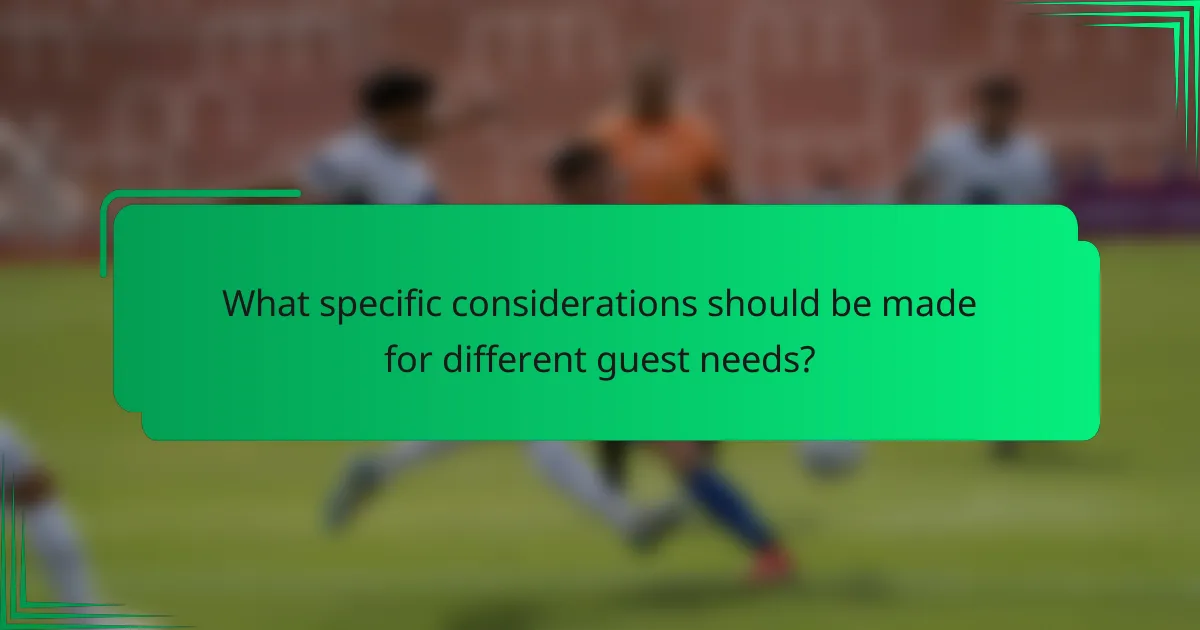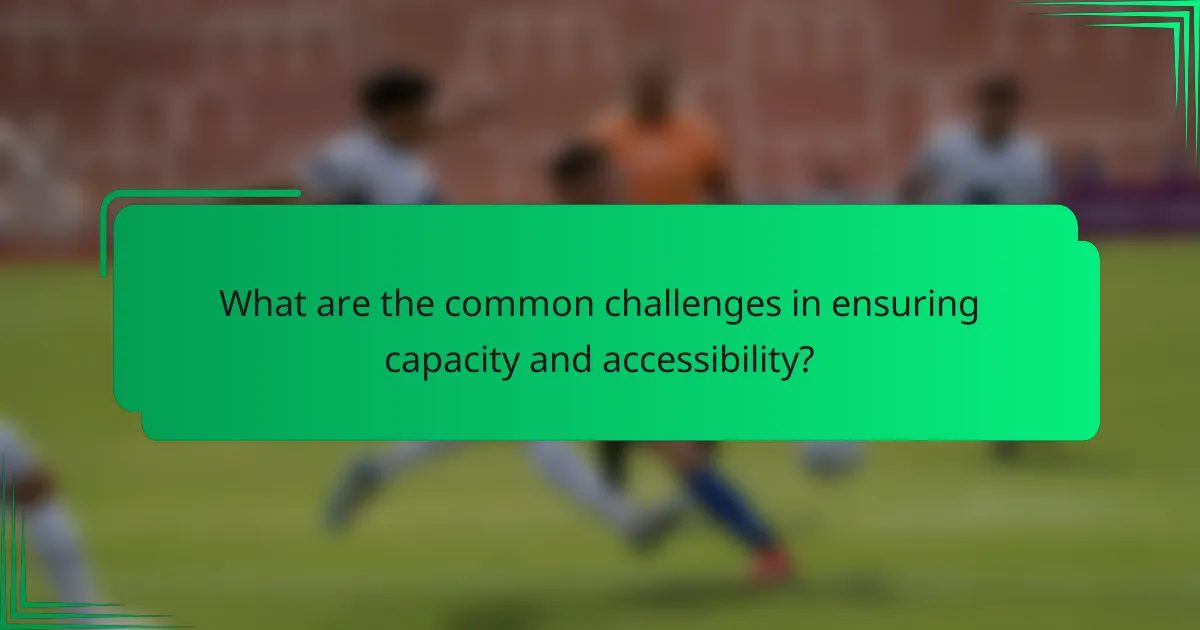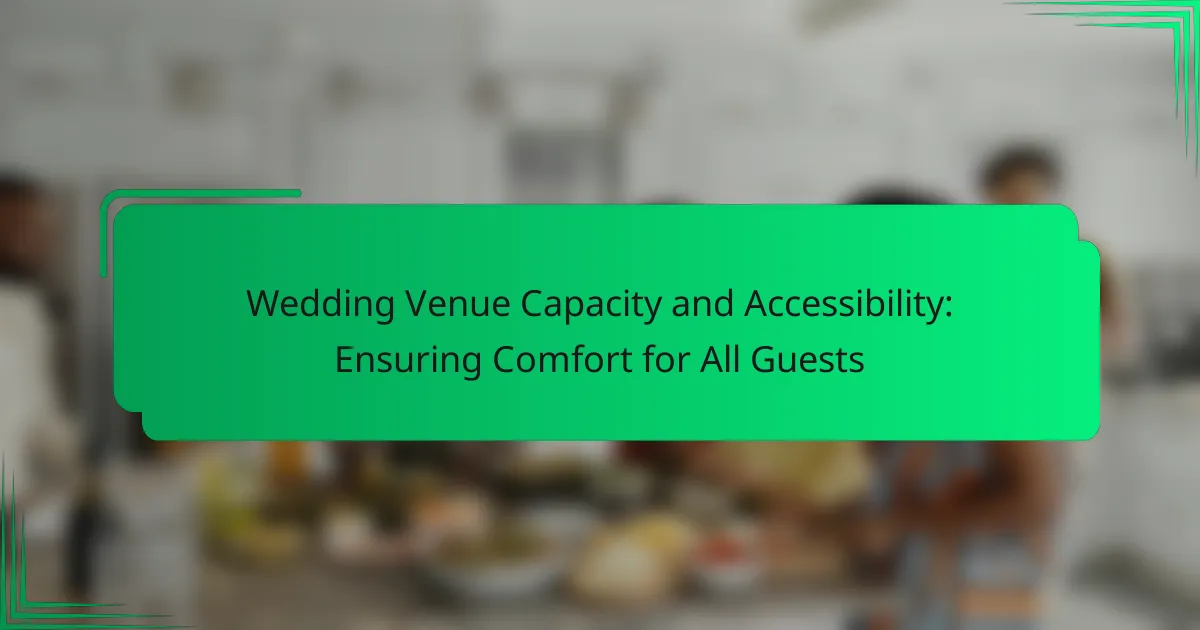Wedding venue capacity and accessibility are critical factors that impact the overall experience of guests at events. The article outlines how venue size, layout, and design influence guest accommodation, while accessibility features such as ramps and elevators are essential for individuals with mobility challenges. It highlights the importance of considering diverse guest needs, including dietary restrictions, seating arrangements, and sensory accommodations, to ensure inclusivity. Additionally, the article addresses common challenges faced by wedding venues, such as physical space limitations, inadequate accessibility features, and compliance with legal standards, emphasizing the need for careful planning to enhance guest comfort.

What factors influence wedding venue capacity and accessibility?
Wedding venue capacity and accessibility are influenced by several key factors. The size of the venue directly determines how many guests it can accommodate. Layout and design also play a crucial role in maximizing space utilization. Accessibility features, such as ramps and elevators, are essential for guests with mobility challenges. Parking availability impacts how easily guests can reach the venue. Local regulations may impose restrictions on capacity limits based on safety codes. Additionally, the type of event can influence the required space, as seated dinners require more room than cocktail receptions. Venue location affects both accessibility and capacity due to geographical constraints.
How is wedding venue capacity determined?
Wedding venue capacity is determined by the available space and local regulations. The venue’s square footage plays a crucial role in capacity calculations. Typically, a guideline is that 10 square feet per guest is required for a seated meal. This guideline can vary based on the event type and seating arrangement. Local fire codes also impose restrictions on maximum occupancy. These codes ensure safety and compliance with legal standards. Additionally, the venue layout affects capacity. Open spaces may accommodate more guests than those with numerous walls or barriers.
What measurements are used to assess capacity?
Measurements used to assess capacity include square footage, seating arrangements, and fire code regulations. Square footage determines the overall space available for guests. This measurement indicates how many people can fit comfortably. Seating arrangements affect how many guests can be accommodated. Different layouts, such as banquet or theater style, influence capacity. Fire code regulations set maximum occupancy limits for safety. These regulations ensure that venues do not exceed safe limits. Each measurement provides a clear framework for assessing venue capacity.
How do different seating arrangements affect capacity?
Different seating arrangements significantly affect the capacity of a venue. Traditional rows maximize seating but may limit interaction. Round tables promote conversation but reduce the number of guests per table. U-shaped or banquet arrangements can enhance visibility but also decrease overall capacity. For example, a theater-style setup can accommodate more guests than a circular arrangement. The layout chosen should consider the balance between capacity and guest comfort. Research indicates that optimal spacing can enhance guest experience while maintaining capacity limits.
Why is accessibility important for wedding venues?
Accessibility is important for wedding venues to ensure all guests can participate fully. Accessible venues accommodate individuals with disabilities, providing equal access to facilities. This inclusivity fosters a welcoming environment for everyone. According to the Americans with Disabilities Act (ADA), venues must meet specific accessibility standards. These standards include wheelchair ramps, accessible restrooms, and designated seating. Ensuring accessibility can also enhance the venue’s reputation and attract a broader clientele. Furthermore, accommodating all guests can lead to more memorable experiences for everyone involved.
What are the legal requirements for accessibility in wedding venues?
Wedding venues must comply with the Americans with Disabilities Act (ADA) to ensure accessibility. This includes providing wheelchair access to entrances, restrooms, and dining areas. Venues must also have designated accessible parking spaces. The ADA mandates that at least 5% of seating be accessible for individuals with mobility impairments. Additionally, venues should offer clear signage indicating accessible routes and features. Compliance with local building codes may also impose further requirements. These legal standards aim to create an inclusive environment for all guests.
How does accessibility impact guest experience?
Accessibility significantly enhances guest experience by ensuring that all individuals can participate fully. When venues are accessible, they accommodate guests with diverse needs, including those with mobility impairments. This inclusion fosters a welcoming atmosphere and promotes social interaction among guests. A study by the National Organization on Disability found that 56 million Americans have disabilities, highlighting the importance of accessibility in event planning. Furthermore, accessible venues often feature ramps, designated seating, and accessible restrooms, which contribute to overall comfort. Guests are more likely to enjoy their experience when they feel considered and valued. Thus, accessibility directly correlates with positive guest experiences at events.

What specific considerations should be made for different guest needs?
Different guest needs require specific considerations to ensure comfort and accessibility. First, assess mobility requirements for guests with disabilities. Venues should have ramps, elevators, and accessible restrooms. Second, consider dietary restrictions. Offer a variety of meal options to accommodate allergies and preferences. Third, think about seating arrangements. Provide options for those who may need extra space or specific seating types. Fourth, include sensory accommodations. This can involve quiet areas for guests who may be overwhelmed by noise. Fifth, ensure clear communication. Provide information about venue layout and services in advance. These considerations enhance guest experience and ensure inclusivity at events.
How can venues accommodate guests with disabilities?
Venues can accommodate guests with disabilities by implementing accessible features. These features include wheelchair ramps, accessible restrooms, and designated parking spaces. Venues should also provide clear signage with large print and Braille. Staff training on assisting guests with disabilities is essential. Offering seating arrangements that allow for mobility aids is important. Venues may also consider providing assistive listening devices. Compliance with the Americans with Disabilities Act (ADA) ensures legal accessibility standards. According to the ADA, venues must remove barriers to access for individuals with disabilities.
What features should be included for wheelchair accessibility?
Wheelchair accessibility should include ramps, wide doorways, and accessible restrooms. Ramps must have a gentle slope to ensure safety and ease of use. Doorways should be at least 32 inches wide to accommodate wheelchairs. Accessible restrooms must have grab bars and enough space for maneuvering. Designated parking spaces should be close to the venue entrance. Elevators are essential for multi-level venues. Additionally, clear signage should guide wheelchair users effectively. These features comply with the Americans with Disabilities Act (ADA) standards, ensuring inclusivity and comfort for all guests.
How can venues ensure comfort for hearing and visually impaired guests?
Venues can ensure comfort for hearing and visually impaired guests by implementing specific accessibility features. Installing hearing loops or assistive listening devices can enhance audio clarity for guests with hearing impairments. Providing braille signage and tactile maps ensures visually impaired guests can navigate the venue independently. Offering trained staff to assist guests with disabilities can create a welcoming environment. Using clear, high-contrast visuals helps visually impaired guests identify important information. Ensuring seating arrangements accommodate wheelchairs promotes inclusivity. Conducting regular accessibility audits can identify areas for improvement. These measures align with the Americans with Disabilities Act (ADA) requirements, enhancing overall guest experience.
What are the best practices for planning guest accommodations?
The best practices for planning guest accommodations include assessing the number of guests and their needs. Start by determining the total guest count to ensure adequate space. Consider accessibility features for guests with disabilities. Evaluate nearby lodging options for convenience and comfort. Communicate accommodation details clearly to guests well in advance. Provide transportation options if necessary to facilitate movement. Lastly, gather feedback from guests after the event to improve future planning. These practices enhance guest experience and ensure comfort during the event.
How can venues provide adequate seating for varying guest numbers?
Venues can provide adequate seating for varying guest numbers by implementing flexible seating arrangements. This can include using modular furniture that can be easily rearranged. Venues can also offer a variety of seating options, such as chairs, benches, and lounge areas. Additionally, venues should have a clear understanding of their maximum capacity and layout. This allows for effective planning based on RSVP numbers. Utilizing technology, such as online seating charts, can help in managing guest arrangements. Venues can also consider outdoor spaces for overflow seating. This adaptability ensures comfort for all guests regardless of attendance fluctuations.
What strategies can be employed to manage crowd flow effectively?
Effective crowd flow management can be achieved through several strategies. First, clear signage should be used to direct guests efficiently. This reduces confusion and helps maintain a steady flow. Second, designated entry and exit points can streamline movement. Having separate pathways for arrivals and departures minimizes congestion. Third, employing staff to guide guests can enhance flow. Trained personnel can assist in managing lines and directing traffic. Fourth, utilizing barriers or ropes can create organized pathways. This visual guidance encourages orderly movement. Lastly, staggered entry times can prevent overcrowding. By controlling the number of guests entering at once, venues can maintain comfort and accessibility. These strategies have been proven effective in various event settings, ensuring guests enjoy a smooth experience.

What are the common challenges in ensuring capacity and accessibility?
Common challenges in ensuring capacity and accessibility at wedding venues include physical space limitations and design barriers. Many venues have fixed seating arrangements that may not accommodate all guests comfortably. Accessibility features, such as ramps and restrooms, are often inadequate or poorly maintained. Additionally, venues may lack sufficient parking or transportation options for guests with mobility issues. Compliance with legal accessibility standards can also be inconsistent. These challenges can lead to discomfort and exclusion for some guests, impacting their overall experience. Addressing these issues requires careful planning and consideration of diverse guest needs.
What obstacles do couples face when selecting accessible venues?
Couples face several obstacles when selecting accessible venues. One major challenge is the availability of venues that meet accessibility standards. Many venues lack adequate wheelchair access, ramps, or elevators. Additionally, couples often encounter limited parking options for guests with disabilities. Another obstacle is the lack of information regarding accessibility features at potential venues. Some venues do not clearly communicate their accessible amenities. Couples may also face budget constraints, as accessible venues can sometimes be more expensive. Finally, couples must consider the layout and space of the venue to ensure it accommodates all guests comfortably.
How can budget constraints affect venue choices?
Budget constraints significantly limit venue choices for weddings. Couples may have to prioritize affordability over desired features. This can lead to selecting smaller venues or those in less desirable locations. Many couples might opt for off-peak dates to reduce costs. Venues with all-inclusive packages may become more appealing due to their value. Limited budgets can also restrict the number of guests invited, impacting venue capacity requirements. As a result, couples often compromise on aesthetics or amenities. According to a survey by The Knot, 45% of couples cite budget as the primary factor influencing their venue selection.
What are the limitations of certain venue layouts?
Certain venue layouts can limit guest interaction and accessibility. For example, a theater-style layout may restrict movement and conversation among guests. This layout often places attendees in fixed seating, which can hinder socializing. Additionally, venues with multiple levels can pose challenges for individuals with mobility issues. Stairs or uneven surfaces may prevent some guests from accessing certain areas. Furthermore, open layouts may lead to noise distractions, making it difficult for guests to communicate. Inadequate space between tables can also restrict movement, causing discomfort. Overall, the choice of layout significantly impacts the overall guest experience at weddings.
What solutions can be implemented to overcome these challenges?
Increase venue capacity by selecting larger spaces that accommodate more guests comfortably. Implement flexible seating arrangements to maximize space utilization. Ensure accessibility features such as ramps and elevators are installed for guests with mobility challenges. Provide clear signage throughout the venue to assist all guests in navigating the space. Offer transportation options for guests who may have difficulty reaching the venue. Collaborate with vendors to provide accommodations for dietary restrictions and other special needs. Conduct a thorough assessment of guest requirements during the planning phase to address potential challenges early. These strategies enhance the overall guest experience and ensure inclusivity at the event.
How can couples advocate for better accessibility in venues?
Couples can advocate for better accessibility in venues by directly communicating their needs to venue management. They should inquire about specific accessibility features such as ramps, elevators, and accessible restrooms. Couples can also request detailed information regarding seating arrangements that accommodate guests with mobility challenges. Engaging in discussions with venue staff about potential improvements can lead to better solutions. Couples may consider sharing personal stories to highlight the importance of accessibility. Collaborating with other couples who share similar concerns can amplify their message. They can also utilize social media platforms to raise awareness about accessibility issues in venues. Research indicates that 1 in 5 Americans has a disability, emphasizing the need for accessible spaces.
What resources are available to assist in finding accessible venues?
Accessible venue directories are available to assist in finding accessible venues. Websites like AccessNow and ADA National Network provide comprehensive listings. These platforms allow users to search based on specific accessibility features. Local government websites often include resources for accessible venues as well. Nonprofit organizations focused on disability rights also offer guidance. Event planning apps may feature filters for accessibility options. Reviews and testimonials from previous users can provide insights into venue accessibility. These resources ensure that venues meet the necessary standards for all guests.
What tips can help couples ensure a comfortable experience for all guests?
Couples can ensure a comfortable experience for all guests by selecting an appropriate venue size. The venue should accommodate the guest list comfortably, allowing for easy movement. Consideration of accessibility is crucial. Ensure that the venue is wheelchair accessible and has adequate facilities for guests with disabilities. Providing clear signage throughout the venue helps guests navigate easily. Couples should also consider temperature control, ensuring the venue is neither too hot nor too cold. Adequate seating arrangements can enhance comfort during the event. Additionally, offering a variety of food and drink options caters to different dietary needs. Engaging a professional planner can help manage these aspects effectively.
The main entity of this article is wedding venue capacity and accessibility, which are critical factors in ensuring a comfortable experience for all guests. The article examines the various influences on venue capacity, including size, layout, local regulations, and seating arrangements, while emphasizing the importance of accessibility features for individuals with disabilities. It also highlights legal requirements under the Americans with Disabilities Act (ADA) and provides best practices for planning accommodations that cater to diverse guest needs. Additionally, the article addresses common challenges couples face when selecting venues and offers strategies to enhance guest experience through effective crowd management and inclusive design.
